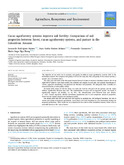Cacao agroforestry systems improve soil fertility: Comparison of soil properties between forest, cacao agroforestry systems, and pasture in the Colombian Amazon
Date
01-2021Author
Rodríguez Suárez, Leonardo
Suárez Salazar, Juan Carlos
Casanoves, Fernando
Ngo Bieng, Marie Ange
Type
Artículo
Metadata
Show full item recordAbstract
The objective of our work was to evaluate soil quality in different cacao agroforestry systems (AFS) in the Colombian Amazon. We compared soil quality of AFS at the study site with soil quality of two control systems: a pasture and a secondary forest. The study was conducted at the Macagual Amazon Research Center in western Colombian Amazon. We set up eight 600 m2 plots in each study system. We collected soil samples in each plot, and assessed macrofauna diversity, aggregate morphology, and physical and chemical soil properties. We integrated these variables in a General Indicator of Soil Quality (GISQ). We found GISQ values of 0.85 for forest, 0.5, 0.65 and 0.59 for AFS and 0.21 for pasture, and the values differed significantly between land uses. The establishment of cacao AFS on degraded pasture was found to significantly improve soil fertility, i.e., by 42%. The intensification level between land uses (Pasture > AFS > Forest) negatively affected macrofauna populations due to soil compaction (physical properties). Forest had the highest physical and biological quality. Our results show that AFS not only have the capacity to maintain key soil ecological functions, but also to restore soil quality of degraded pastureland. Cacao-based AFS could therefore be a key restoration strategy for degraded pastureland. These results are very important in the context of the Colombian Amazon, where cacao is currently known as the “crop of peace”.
Keywords
Publisher
Elsevier, Ámsterdam (Países Bajos)
Is part of
Agriculture, Ecosystems and Environment
URI (Permanet link to cite or share this item)
https://doi.org/10.1016/j.agee.2021.107349https://repositorio.catie.ac.cr/handle/11554/10654


